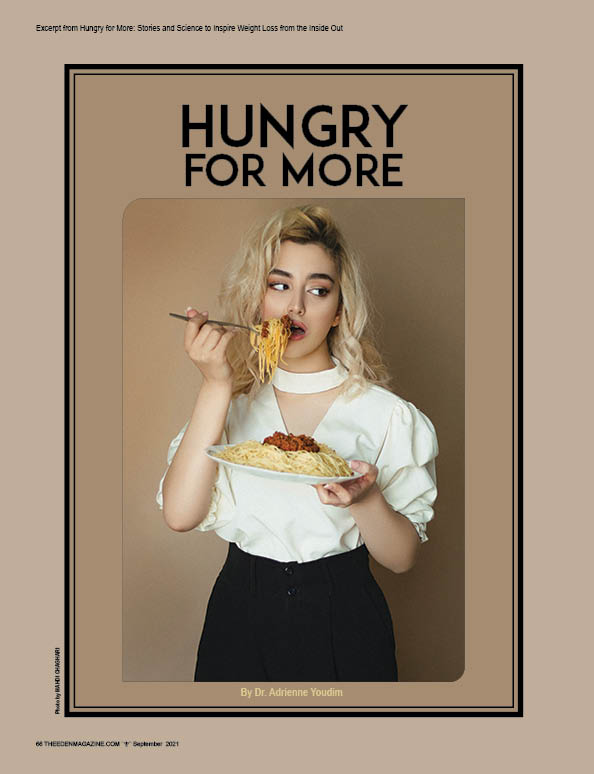By Dr. Adrienne Youdim
Excerpt from Hungry for More: Stories and Science to Inspire Weight Loss from the Inside Out
We must redefine the term “comfort food,” because we’re actually doing the opposite when we eat sugary and fatty foods, according to Adrienne Youdim, MD, FACP–an internist who specializes in medical weight loss and nutrition, and is author of Hungry for More: Stories and Science to Inspire Weight Loss from the Inside Out (the #2 Best New Release in Diet Therapy books on Amazon). She is known to prescribe books, podcasts, and has even written a prescription for a puppy. It’s what makes her approach to weight loss so successful.“It’s no surprise we turn to fried chicken and warm chocolate chip cookies,” says Dr. Youdim. “These foods stimulate dopamine in the same way emotional connection and heartfelt conversation and belonging stimulate dopamine. Certain foods may represent comfort, but they do not actually provide comfort, not in the long run. When we eat unprocessed foods, fresh fruits and vegetables, lean protein, high quality carbohydrates, our bodies actually feel good, comfortable.”
The marriage between food and emotion is hardwired in our neurochemistry. In the many years of doing this work, rarely have I encountered a human whose emotions did not inform their eating. When we are happy, we eat. When we are sad, we eat. When we are longing, tired, and hopeless, we eat. The hormones that manage our hunger respond to food and nutrients, but they also respond to our emotions. In fact, our emotions literally hijack our hunger hormones. Research has shown that when animals are subjected to stress, they respond with increased hormone ghrelin. Ghrelin is a hormone that is released from the stomach, signaling hunger to the brain. In normal physiology, an empty stomach will trigger the release of ghrelin. Still, studies show that stress will cause the release of ghrelin as well, triggering hunger and the desire to eat irrespective of food intake, resulting in weight gain.
But there are other ways in which food and hunger are connected in the brain. The limbic system is the part of our brain that is responsible for processing sensory input and emotional experiences such as pleasure and motivation. The structures of the limbic system are stimulated by alcohol, sex, drugs, and, not surprisingly, by food. When we eat highly palatable foods such as sugar and fat, dopamine, a feel-good chemical messenger in the brain or neurotransmitter, is released. Dopamine is responsible for the feeling of pleasure and satisfaction we experience when we eat. Dopamine boosts our mood and makes us feel happy, even euphoric, in the moment. Dopamine also interacts with other parts of our brains to coordinate a feeling of reward, reinforcing the positive feelings that arise from eating palatable foods and motivating us to do so repeatedly, thereby creating a habit.
When we eat a chocolate chip cookie, for example, dopamine is released, and we feel pleasure. Dopamine stimulates the pre-frontal cortex, the thinking part of the brain that helps us make the decision to eat more or to eat it again.
Yum, that cookie was good. I think I would like to eat more.
Dopamine also acts upon the hippocampus and amygdala, the parts of the brain that are responsible for emotional responses and the formation of memories. So, if your mother happened to make you fresh chocolate chip cookies when you were young to cheer you up when you were sad, dopamine would have signaled these structures to store that emotional memory.
My mom loves me. She made me chocolate chip cookies to make me feel better. Months, years, even decades later, you will recall that sweet memory whenever you come across the smell of fresh-baked cookies as a feeling of love, attention, and care. Finally, dopamine informs the nucleus accumbens, the part of the brain that executes the actions you contemplate. I will walk to the pantry to get more cookies. Or in my case, grilled cheese.
As if all of this were not enough, dopamine has yet another way of promoting the habitual intake of palatable foods. Over time, dopamine becomes less responsive to the food or foods we eat, which means that more food is required to trigger the release of dopamine and, therefore, the pleasurable effects of the food. So not only are we motivated to eat the chocolate cookie again, but we are required to eat more of it in order to get the emotional payoff. As palatable foods will result in pleasurable feelings, we become motivated to seek these foods in a repeated habitual way, particularly when there is emotional distress, so that we can reproduce feelings of pleasure. In these ways, food becomes synonymous with positive emotions and comfort.
Comfort food did not get its name from anywhere. Based on all the mechanisms I described, comfort food does provide comfort in the moment. But when the dopamine wears off, we are left unsatisfied and desiring more, which in essence is not comfort. If we pay close attention to when we do indulge in comfort foods, we actually do not feel comfortable at all. Foods with excessive sugar, for example, result in a feeling of irritability and restlessness followed by sluggishness and fatigue. Food that is high in fat usually leaves us feeling tired, drained, even lethargic. In reality, food that is completely the opposite of what we perceive as “comfort” is the food that, in fact, makes us feel comfortable. When we eat unprocessed foods, fresh fruits and vegetables, lean protein, high-quality carbohydrates, our bodies feel good, comfortable. Certain foods may represent comfort, but they do not actually provide comfort, not in the long run.







